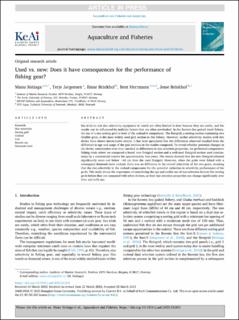| dc.contributor.author | Sistiaga, Manu | |
| dc.contributor.author | Jørgensen, Terje | |
| dc.contributor.author | Brinkhof, Ilmar | |
| dc.contributor.author | Herrmann, Bent | |
| dc.contributor.author | Brinkhof, Jesse | |
| dc.date.accessioned | 2023-07-04T08:25:40Z | |
| dc.date.available | 2023-07-04T08:25:40Z | |
| dc.date.created | 2023-06-08T13:59:30Z | |
| dc.date.issued | 2023 | |
| dc.identifier.citation | Aquaculture and Fisheries. 2023, . | en_US |
| dc.identifier.issn | 2468-550X | |
| dc.identifier.uri | https://hdl.handle.net/11250/3075473 | |
| dc.description.abstract | Sea trials to test size selectivity equipment in trawls are often limited in time because they are costly, and the results can be influenced by multiple factors that are often overlooked. In the Barents Sea gadoid trawl fishery, the use of a size sorting grid in front of the codend is compulsory. The flexigrid, a netting section containing two flexible grids, is the most widely used grid section in this fishery. However, earlier selectivity studies with this device have shown inconclusive results. It has been speculated that the differences observed resulted from the difference in age and usage of the grid sections in the studies compared. To reveal whether potential changes in the device construction over time can lead to differences in size selection properties, we performed comparative fishing trials where we compared a brand new flexigrid section and a well-used flexigrid section used continuously by a commercial trawler for approximately four years. The results showed that the new flexigrid released significantly more cod below ∼60 cm than the used flexigrid. However, when the grids were fished with a subsequent diamond mesh codend, there was no difference in the overall selectivity of the two gears, meaning that the size selectivity in the codend compensates for the potential reduction in selectivity performance of the grids. This study shows the importance of considering the age and earlier use of size selection devices like sorting grids before they are compared with other devices, as their size selection properties can change significantly over time and with use. | en_US |
| dc.language.iso | eng | en_US |
| dc.title | Used vs. new: Does it have consequences for the performance of fishing gear? | en_US |
| dc.title.alternative | Used vs. new: Does it have consequences for the performance of fishing gear? | en_US |
| dc.type | Peer reviewed | en_US |
| dc.type | Journal article | en_US |
| dc.description.version | publishedVersion | en_US |
| dc.source.pagenumber | 0 | en_US |
| dc.source.journal | Aquaculture and Fisheries | en_US |
| dc.identifier.doi | 10.1016/j.aaf.2023.03.003 | |
| dc.identifier.cristin | 2153093 | |
| cristin.ispublished | true | |
| cristin.fulltext | original | |
| cristin.qualitycode | 1 | |
